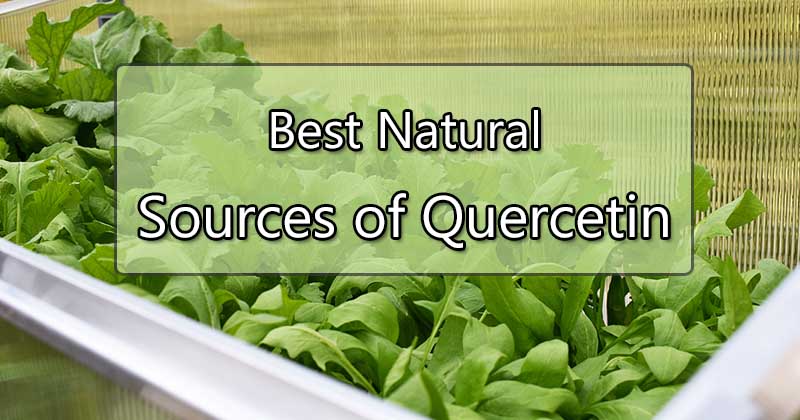Foods like berries, apples, grapes and onions often get listed as good natural sources of quercetin. However, according to the USDA database, these foods aren’t necessarily rich in quercetin. Here is a table of foods high in quercetin.
Quick Answer:
Containing 173mg per 100g, capers are by far the richest natural source of quercetin. Many leafy greens also contain high amounts of quercetin, especially lovage, dock, radish leaves and rocket. Onions can also be a good source of quercetin but it is mostly concentrated in the outer parts of the bulbs and is destroyed by cooking. Contrary to common belief, wine is not a very good source of quercetin.
Best Natural Sources of Quercetin
These levels come from the USDA database. Amounts are mg of quercetin per 100g of food.
| Capers | 173 |
|---|---|
| Lovage, leaves, raw | 170 |
| Dock, raw (Rumex spp.) | 86 |
| Radish leaves, raw | 70 |
| Rocket, wild, raw (Diplotaxis tenuifolia) | 66 |
| Carob fiber (Caromax) | 58 |
| Dill weed | 55 |
| Coriander (cilantro) leaves, raw | 53 |
| Peppers, hot, yellow wax, raw | 51 |
| Fennel, leaves, raw | 49 |
| Juniper berries, ripe | 47 |
| Juniper berries, green, unripe (Juniperus communis) | 43 |
| Oregano | 42 |
| Red onions, raw | 40 |
| Carob flour (Ceratonia siliqua) | 39 |
| Radicchio, raw (Cichorium intybus | 32 |
| Spring onion bulb | 31 |
| Watercress, raw (Nasturtium officinale) | 30 |
| Ancho peppers | 28 |
| Elderberries | 27 |
| Onions pan fried, white | 27 |
| Nalta jute, raw | 24 |
| Current | 23 |
| Kale, raw (Brassica oleracea (Acephala Group) | 23 |
| Raw okra | 21 |
| Bee pollen | 21 |
| Raw onions | 20 |
| Apple skin | 19 |
| Chia seeds | 18 |
| Sour cherries | 17 |
| Service (Saskatoon) berries (Amelanchier canadensis) | 17 |
| Drumstick (horseradish tree) leaves, raw (Moringa oleifera) | 17 |
| Sweet potato leaves, raw (Ipomoea batatas) | 17 |
| Raw cranberry juice | 16 |
| Peppers, serrano, raw (Capsicum anuum) | 16 |
| Asparagus, cooked, boiled, drained | 15 |
| Sweet onions, raw | 15 |
| Hot chili peppers, green raw | 15 |
| Buckwheat (Fagopyrum esculentum Moench) | 15 |
| Buckwheat bran | 15 |
| Raw cranberries | 14 |
| Goji dried | 14 |
| Plums, black diamond, with peel, raw | 13 |
| Spring onion, leaves | 13 |
| Onions white cooked boiled drained | 11 |
| Blueberries | 8 |
| Arugula, raw (Eruca sativa) | 8 |
Cooking Destroys Quercetin
Exposure to heat will destroy quercetin. As a result, cooked foods will typically have lower levels of quercetin than the raw food. This is problematic as many natural sources of quercetin aren’t usually eaten raw. Boiling is particularly bad because the quercetin is lost to the water. Steaming or sautéing is a better option for preserving quercetin in foods.
Storage Also Reduces Quercetin
Levels of quercetin in foods also reduce in storage. In one study, it was found that onions lost 33% of their quercetin content in the first 12 days of storage. This is problematic since many foods we buy in the supermarket have actually been sitting in storage for a long time.
For example, apples are typically stored for 6-12 months before they make it to the supermarket shelves! Onions are often stored for 8 months before making it to the supermarket. This is just one more reason to buy fresh, seasonal foods from local sources.
Skins and Peels Contain the Most Quercetin
Researchers believe that plants have quercetin to protect them against damage from UV light. As a result, most quercetin in plants is found in the outer parts of the plant. For example, a peeled apple only has about 0.4-1mg of quercetin per 100g whereas the peel contains 19mg per 100g.
Likewise, the amount of quercetin can vary depending on the part of the plant. Spring onion leaves have very little quercetin but the bulbs (particularly the outer parts) are very rich in quercetin.
Is Wine a Good Source of Quercetin?
According to the USDA database, wine is not a good source of quercetin. White wine has almost no quercetin and most red wines only contain 0.58-1mg of quercetin per 100ml. Shiraz wine has slightly more quercetin (2.11mg per 100ml), but even this does not come close to the levels of quercetin found in other natural sources such as radish leaves or oregano.
Not All Natural Sources of Quercetin Are Equal
One problem with the USDA database is that it doesn’t factor in the bioavailability of quercetin in foods. There are actually several different forms of quercetin and some are absorbed by the body better. For example, onion peel powder (rich in quercetin glycosides) is better absorbed than apple peel powder.
On top of that, the amount of quercetin in a food can vary drastically depending on growing conditions. Growing conditions, soil health, exposure to light and climate all affect how much quercetin a plant will contain.
The Bottom Line?
If you want to get quercetin from natural sources, you’ll need to eat a wide variety of foods – preferably raw and from fresh, local sources. Otherwise, you will need to take a quercetin supplement which has been standardized and formulated for bioavailability.

